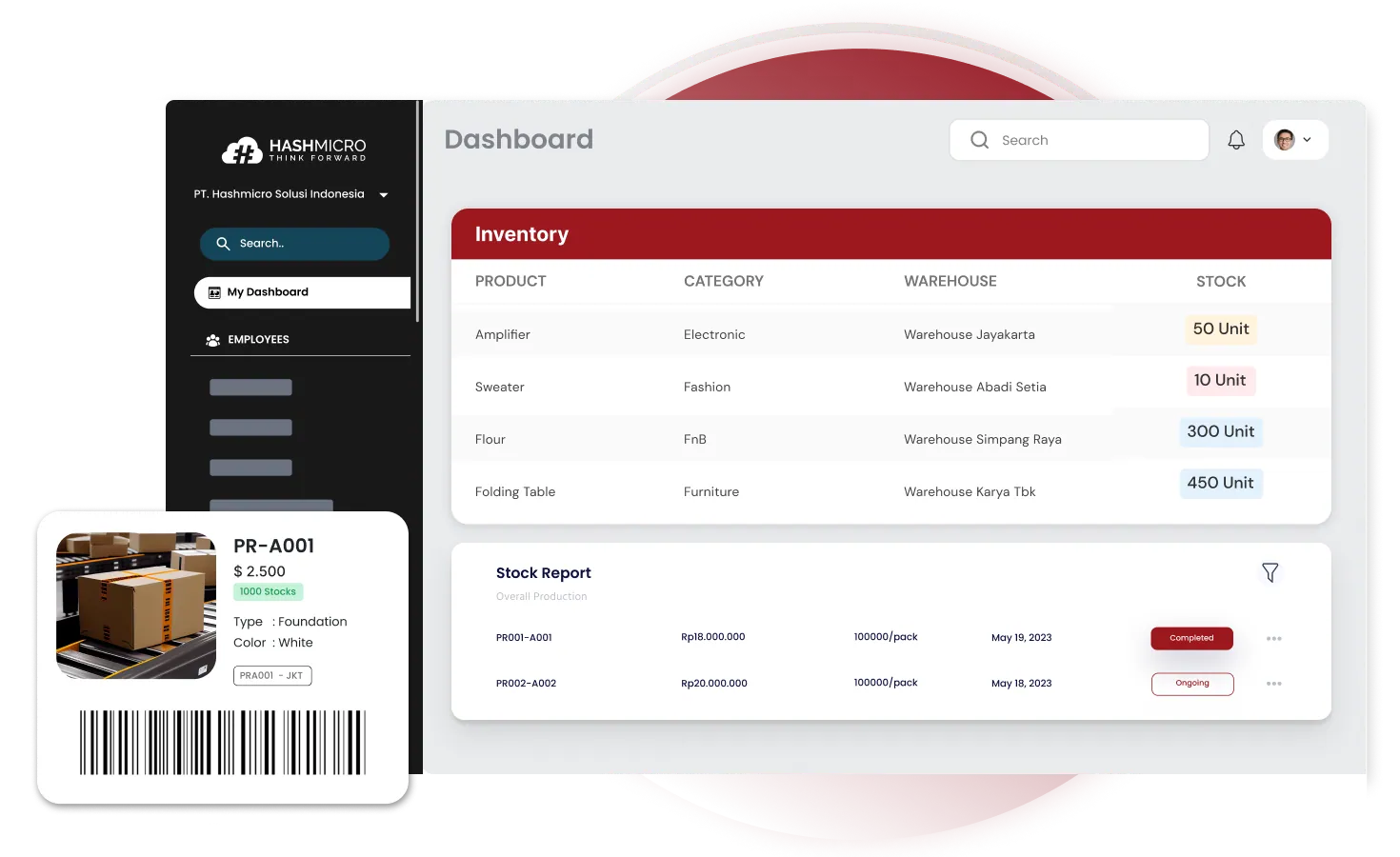Managing stock levels is often complex and time-consuming. From my experience, AI inventory management offers a game-changing solution. It automates processes, improves accuracy, and transforms inventory control. One study even found that AI in retail supply chains reduced inventory costs by 18% and boosted order fulfillment by 22%.
In this article, I’ll share how AI-driven inventory management enhances efficiency, reduces costs, and improves customer satisfaction. You’ll also discover how solutions like Hashy AI by HashMicro can help your business stay ahead in Singapore. Want to see it in action? Try our free demo today!
Key Takeaways
|
What is AI Inventory Management?
AI Inventory Management is the use of artificial intelligence to optimize inventory control. It enhances decision-making by applying machine learning, predictive analytics, and real-time data to maintain optimal stock levels and reduce inefficiencies.
From my experience, effective inventory management helps businesses meet customer demand without overstocking or stockouts. I’ve seen how AI enhances accuracy, reduces operational costs, and improves supply chain responsiveness. Minimizing errors allows companies to operate more efficiently and boost profitability.
AI-driven inventory management enables real-time tracking and predictive demand forecasting. Businesses can respond quickly to market fluctuations, improving resilience and competitiveness. AI also facilitates seamless integration with digital supply chain systems.
Evolution from Conventional to AI Inventory Management
From what I’ve observed, inventory management has come a long way, from manual tracking with handwritten ledgers to advanced AI-powered systems. I’ve seen how traditional methods were time-consuming and prone to errors, often causing stock discrepancies. Today, modern solutions greatly enhance accuracy and streamline overall supply chain operations.
The 1980s introduced computer-based inventory systems, automating data entry, order tracking, and stock reconciliation. Barcode scanning and ERP integration further improved efficiency, allowing businesses to manage larger inventories precisely. These advancements also made maintaining an inventory list easier, ensuring accurate real-time tracking.
Advancements in technology have introduced features such as real-time tracking, predictive analytics, and cloud-based solutions into inventory management systems. AI now drives smart automation and data-driven decision-making, optimizing stock levels and mitigating risks. This evolution transforms inventory management into an intelligent, agile, and efficient process called AI inventory management.
What is the Role of AI in Inventory Management in Business?
From my perspective, companies are always looking for ways to enhance their operations and gain a competitive advantage. I’ve seen how artificial intelligence (AI) has become a key driver in this pursuit, offering advanced solutions to long-standing inventory management challenges.
By integrating AI into inventory management, I’ve witnessed businesses achieve greater efficiency, accuracy, and responsiveness. AI automates routine processes and delivers real-time insights, helping companies optimize stock levels, anticipate demand, and streamline supply chain operations.
Let’s explore the key roles AI plays in revolutionizing inventory management:
- Demand forecasting: AI inventory management employs machine learning algorithms to analyze historical sales data and predict future consumer demand, enabling businesses to adjust stock levels proactively.
- Real-time inventory tracking: Through the Internet of Things (IoT) and AI integration, companies gain real-time visibility into inventory locations and conditions, facilitating timely decision-making.
- Supplier management: AI analyzes supplier performance metrics, such as delivery times and quality, aiding businesses in selecting reliable partners and negotiating favorable terms.
- Automated replenishment: AI automates the reordering process based on predefined thresholds and demand forecasts, reducing manual intervention and errors.
What are the Key Techniques in AI Inventory Management?

From my experience, AI inventory management uses advanced computational models to process data, recognize trends, and detect inconsistencies. I’ve seen how these techniques allow businesses to manage stock levels with greater precision and adaptability. Here are some of the key AI techniques used in inventory management:
1. Machine learning algorithms
Machine learning models analyze vast inventory data, identifying recurring patterns and deviations. These algorithms continuously improve by learning from new data inputs and refining their ability to recognize shifts in demand or supply.
2. Predictive analytics
This technique utilizes statistical methods and AI-driven models to examine past and present inventory data. It establishes correlations between various factors, such as seasonal changes and purchasing behaviors, to anticipate future stock requirements.
3. Anomaly detection
AI systems scan inventory data for unexpected variations, identifying fluctuations that may indicate inconsistencies. By differentiating between normal stock changes and unusual activity, AI helps detect product flow and irregularities in warehouse operations.
Hashy AI Fact

Need to Know
Hashy AI Inventory is the go-to tool for efficient inventory management. With real-time tracking, auto restocking, and multi-location support, it streamlines operations, avoids overstocking, and keeps products available when needed.
Request a free demo today!
What are the Benefits of Implementing AI in Inventory Management?
From my experience, business automation for growth has become a crucial element in modern inventory management. I’ve seen how it helps companies optimize operations, reduce inefficiencies, and enhance overall performance. Here are some key benefits of AI inventory management:
1. Cost reduction
AI helps prevent overstocking and stockouts by accurately forecasting demand, leading to lower storage costs and reduced financial losses. Automated inventory control minimizes waste and improves resource allocation, ensuring cost efficiency.
2. Improved efficiency
By automating tasks like stock monitoring, order processing, and inventory tracking, AI frees up employees for strategic decision-making, boosting productivity and reducing errors. It also optimizes the inventory valuation method, ensuring accurate and consistent inventory valuation for better financial decisions.
3. Enhanced customer satisfaction
AI-driven demand forecasting ensures businesses maintain optimal stock levels, preventing product shortages. This leads to a smoother shopping experience, increased customer trust, and higher retention rates.
4. Scalability
AI-powered systems can efficiently handle increasing inventory volumes and adapt to fluctuating market conditions. This flexibility makes them suitable for businesses of all sizes, from startups to large enterprises.
Choosing the right AI inventory management solution helps businesses maximize efficiency while staying within budget. With HashMicro’s flexible pricing options, companies can take advantage of advanced features tailored to their needs. Click the banner below to explore the available pricing scheme and find the best solution for your business!
What are the Challenges & Considerations of AI Inventory Management?
From my perspective, while AI offers remarkable advantages in inventory management, I’ve also seen that its implementation comes with several challenges businesses must address. Understanding these factors is essential to harnessing AI’s potential while minimizing risks fully. Here are some key challenges for AI inventory management:
1. Data quality
AI systems rely heavily on accurate and comprehensive data to generate reliable insights. Bad data quality, such as incomplete or outdated information, can lead to incorrect predictions and decisions.
2. Integration complexity
Incorporating AI into existing inventory systems requires compatibility with current infrastructure and workflows. Businesses may face technical challenges, requiring expertise and strategic planning to ensure seamless implementation.
3. Cost implications
AI adoption often involves significant upfront investment in software, hardware, and employee training. Businesses must conduct a thorough cost-benefit analysis to ensure that the long-term efficiency and savings outweigh initial expenses.
Use Cases of AI Inventory Management
I’ve seen how leveraging AI allows businesses in different sectors to optimize inventory processes and respond to market demands more effectively. Here’s how AI is applied in key industries:
- Retail: Retail operations involve managing large product assortments across multiple locations. AI helps retailers track sales patterns, anticipate seasonal demand shifts, and align stock levels with consumer purchasing behavior.
- Manufacturing: Manufacturing industries require precise coordination of raw materials, production schedules, and supply chain logistics. AI assists in monitoring inventory levels, ensuring seamless material flow, and adjusting production plans based on real-time data.
- Logistics: The logistics sector involves complex transportation, warehousing, and distribution networks. AI enables efficient monitoring of shipment movements, warehouse storage conditions, and order fulfillment processes to maintain smooth operations.
Transforming Your Inventory Management with HashMicro Hashy AI

Managing inventory efficiently is crucial to staying competitive. I chose Hashy AI by HashMicro, an advanced AI-powered solution designed to streamline inventory operations and enhance supply chain management for my business.
With intelligent automation and real-time insights, Hashy AI empowers businesses to optimize stock control, procurement, and operational workflows. Leveraging AI-driven inventory management, companies can reduce inefficiencies, minimize human errors, and make data-driven decisions to improve productivity.
Here are the key features that make Hashy AI an essential tool for modern businesses:
- Check Current Stock Levels: AI enables real-time monitoring of stock levels across multiple locations, ensuring businesses have complete visibility over their inventory.
- Low Stock Notification & Recommended Restocking: When stock levels reach critical thresholds, Hashy AI sends automatic alerts and provides AI-driven recommendations for optimal reorder quantities.
- Automated Reordering & Purchase Requests (PR): AI automates stock replenishment by generating purchase requests based on predefined rules, eliminating the risk of human errors.
- Purchase Request (PR) Status Tracking: Users can track the approval and fulfillment status of purchase requests in real-time, reducing delays in procurement processes.
- Expiring Stock Notifications: AI monitors product expiration dates and notifies businesses to take timely action, preventing losses from expired goods.
- Internal Transfer Request Management: Businesses can efficiently request and track internal stock transfers between locations to maintain balanced inventory levels.
- Input Production Levels: Businesses can log production outputs in real-time, helping managers track efficiency and identify areas for improvement.
“AI inventory management empowers businesses to predict demand, automate replenishment, and minimize stock errors. It enhances efficiency, reduces waste, and gives companies a clear competitive edge.”
— Angela Tan, Regional Manager
Conclusion
The application of artificial intelligence (AI) in inventory management has transformed the stock management process into one that is more efficient and accurate. AI’s ability to analyze data in real time and predict demand allows businesses to optimize inventory levels, reduce storage costs, and improve customer satisfaction.
To meet modern business challenges, I trusted HashMicro Hashy AI, which offers a superior AI inventory management solution featuring stock automation, restock notifications, and real-time inventory monitoring. Gain maximum efficiency in inventory management with HashMicro Hashy AI.
Businesses can also use the CTC Grant, which covers up to 70% of the implementation costs, to support adopting digital solutions like Hashy AI from HashMicro. Try a free demo today and experience the future of supply chain efficiency!
FAQ about AI Inventory Management
-
How to create an AI Inventory?
Creating an AI-driven inventory system involves integrating AI technologies with inventory management processes. The steps include:
– Data Collection: Gather historical and real-time inventory data.
– AI Model Development: Use machine learning algorithms to analyze demand patterns and optimize stock levels.
– Integration with ERP/WMS: Connect AI with Enterprise Resource Planning (ERP) or Warehouse Management Systems (WMS) for seamless automation.
– Implementation & Testing: Deploy the AI model, continuously monitor performance, and refine based on insights. -
What are the 4 types of inventory management?
The four main types of inventory management are:
1. Just-In-Time (JIT): Stocks are replenished only when needed, reducing holding costs. 2. Material Requirements Planning (MRP): Uses sales forecasts and production schedules to manage inventory.
3. Economic Order Quantity (EOQ): Determines the optimal order quantity to minimize total inventory costs.
4. Days Sales of Inventory (DSI): Measures how quickly inventory is sold over a given period. -
How to use AI in the supply chain?
AI enhances the supply chain by improving efficiency, reducing costs, and optimizing logistics:
– Demand Forecasting: AI predicts future demand to prevent overstocking or stockouts.
– Warehouse Automation: AI-powered robots and automated picking systems enhance warehouse operations.
– Route Optimization: AI analyzes traffic patterns and delivery schedules to optimize logistics routes.
– Supplier Performance Analysis: AI evaluates supplier reliability, helping businesses make informed procurement decisions. -
Which algorithm is used for inventory management?
Various AI algorithms are used in inventory management, including:
– Time Series Forecasting (ARIMA, LSTM): Predicts demand based on past sales trends.
– Reinforcement Learning: Optimizes inventory policies by continuously learning from data.
– K-Means Clustering: Categorizes inventory items based on demand patterns.
– Decision Trees & Random Forests: Used for inventory classification and stock optimization.




















































